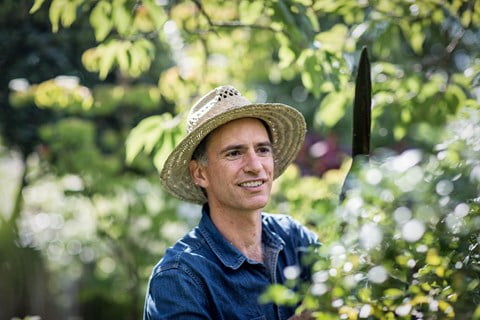
Jake Hobson is a sculptor who just happens to use living trees and shrubs as his medium. He has labelled his skill ‘cloud pruning’, but is equally happy referring to it as ‘organic topiary’ – his own interpretation of the Japanese art of niwaki, after which he has named the side of his company that imports topiary tools from Japan. ‘Niwaki translates literally as “garden tree”,’ he explains. ‘It is the art of pruning trees to keep them in proportion with the garden, to make a microcosm of the landscape around them by clipping and training them into a form that means they don’t lose their shape and character.’ Having begun his career pruning for other people, he now works as a consultant due to a bad back, passing on his techniques to those wanting to transform their own topiary (which works in everyone’s favour, since pruning can never be a once-only task when plants are in continual growth).
Jake’s love affair with Japanese topiary began when he was awarded a travel bursary to Japan in 1997, shortly after he had completed a course in sculpture at the Slade School of Fine Art in London. His objective was to study the artistic and cultural phenomenon of the cherry blossom, but he was more struck by the sculpted trees that peppered Japanese gardens. ‘Each garden is like a miniature landscape, almost like a painting,’ he says. ‘Literally every garden has pruned trees – they’re as common as clipped hedges in this country.’
Within a year, he was planning another visit. He stayed for two years, teaching English and then eventually finding a job in a tree nursery in rural Osaka, where he had an introduction to the complex art of niwaki. A Japanese apprenticeship in tree pruning lasts seven years – it takes that long to learn the intricacies of technique and the dozens of different topiary forms, each of which has its own cultural or spiritual significance. Pruning and training can be done to mimic a windswept tree, for example, or a much older one, with gnarled trunk and branches.
In translating the art for British gardens, Jake has had to find a halfway point. Inevitably, he has found himself sculpting a lot of common box, one of the staple ingredients of an English country garden, but instead of clipping it into strictly measured spheres and cubes, he might give it a more natural, flowing shape. He teaches people to work with other plants, too – Phillyrea latifolia is a favourite, with rich, glossy leaves that clip into tight forms, and the evergreen holm oak. ‘Basically, anything you can clip into a hedge can be used,’ says Jake. ‘You have to understand that each tree is different, with its own character. I particularly enjoy experimenting with different plants and reacting to their character – their leaf size and shape, the way they grow.’
He uses a range of handmade tools for the job, all imported from Japan and available to buy from his website, Niwaki. ‘I use hand tools with high-quality steel blades, crafted by people who have been making them for generations,’ he says. ‘The tools are expensive, but they’re a pleasure to use and they’ll last a lifetime.’
The technique is to start at the top and work your way down, refining it by taking away the clutter. ‘You have to get over your fear of damaging the plant – the types I work with are resilient and, especially if they are long-established, you can cut back significantly. Somewhere in there is a tree that has its own intrinsic shape and form and it’s just a matter of bringing this out.’
As well as advising on the pruning of well-established trees and shrubs, Jake has a nursery of tree specimens that he is clipping and training into bespoke forms, which he sells to clients. Teaching people how to prune and shape their own topiary is crucial. ‘Trees continue growing,’ concludes Jake. ‘As a plant develops, so too does our understanding of that plant. There’s a relationship between the plant and its owner and no conclusion to that relationship; it’s an ongoing thing.’
[Source:- House]



